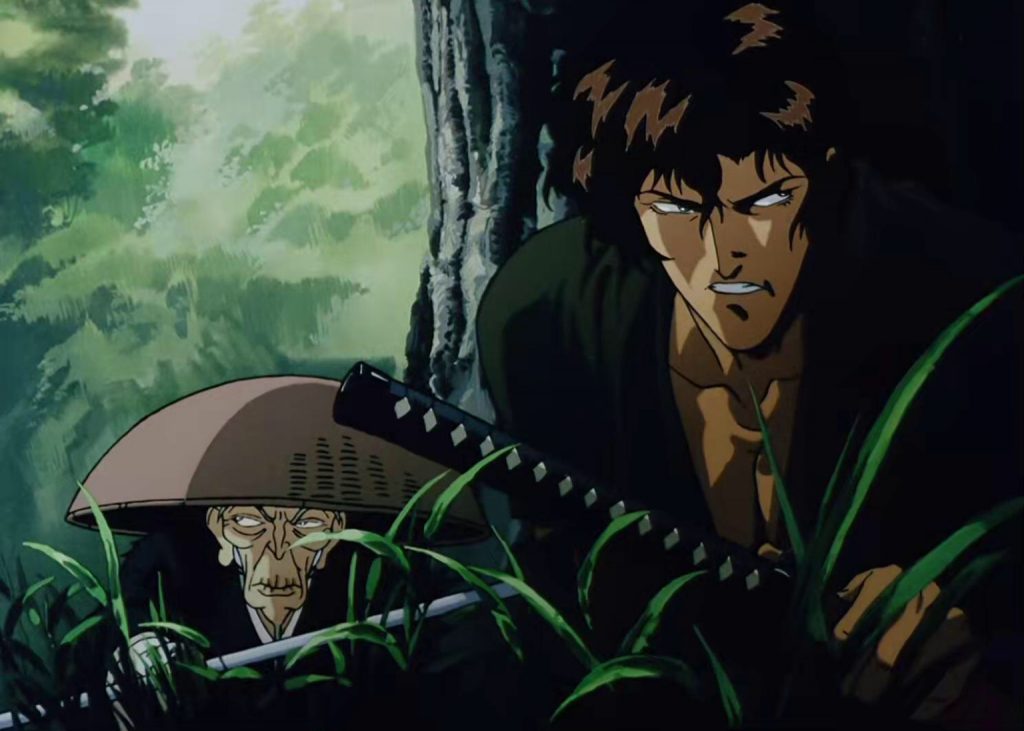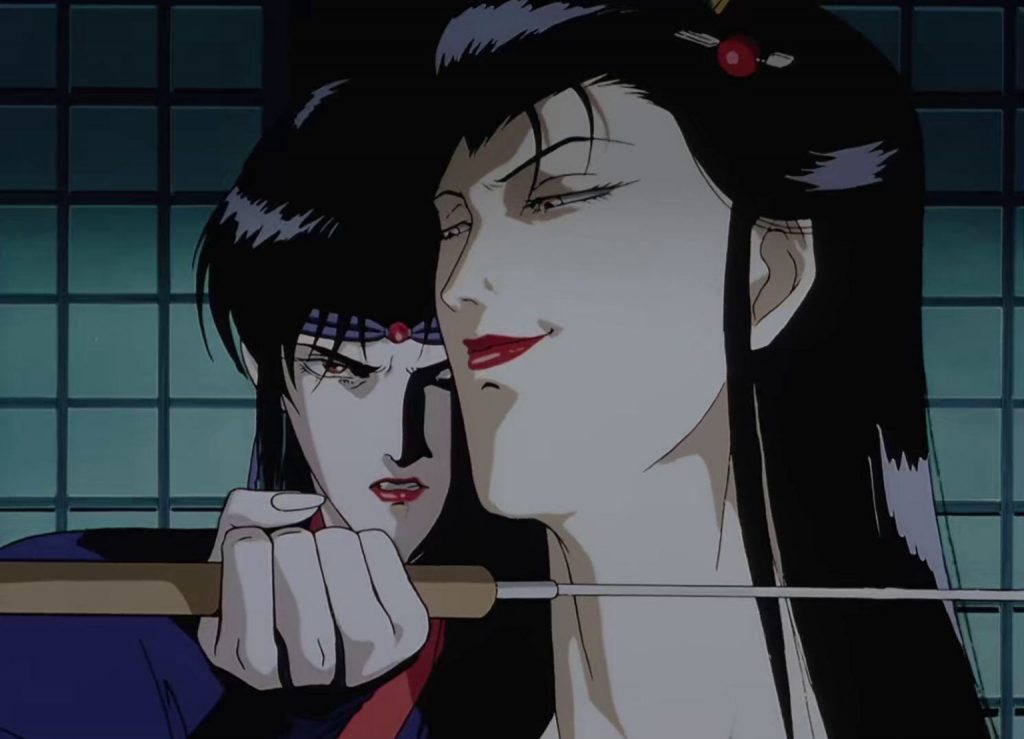Ninja Scroll (1993).
With his blood-soaked 1993 animated epic, Ninja Scroll, director Yoshiaki Kawajiri was disinterested in telling an historically accurate tale despite its setting in Feudal Japan, and cites inspiration from western films such as Die Hard and Blade Runner, as well as Akira Kurosawa’s Yojimbo. With tongue firmly in cheek, Kawajiri attributes some of the credit for him becoming a film director to Hayao Miyazaki, whose style he at one time wanted to emulate before coming to the conclusion that no one can do what Miyazaki does better than Miyazaki himself. So naturally, one instead makes a film like Ninja Scroll.

In truth though Kawajiri more or less fell into the job as director, something that he didn’t earnestly aspire toward but got the job due to his notable work on other projects and the pace with which he drew his storyboards. Ninja Scroll follows Jubei Kibagami, a ninja and a vagabond who travels from place to place providing his services for payment. His hand is forced at the bequest of a conniving, elderly government spy named Dakuan, who poisons him and promises him an antidote if he agrees to work for him.

The antidote takes the form of Kagero, a female ninja whose body is infused with poisonous toxins. Anybody who makes love to her is quick to succumb to her curse. She’s the first of many characters introduced who come equipped with strange, supernatural powers, and she’s quite easily the most interesting, it could be argued that the film falls apart without her. She’s a complicated, rather sensitive person who is, very explicitly, forced into the whims of more powerful men – leading to some upsetting sequences – and has lived a life in which she is seen as little more than an object or a weapon. Her sexuality is a strength and a weakness, and a literal testament to the notion that a woman’s body does not exist for the pleasure of others that allows the film to be re-contextualised for contemporary viewing, but it helps not to forget that this is feudal Japan. It’s also put her at a significant distance from everybody around her, to such an extent that she’s not even sure how to manage a mixture of emotions when Jubei shows her the first courtesies she’s ever experienced.

That’s the only logical reason for her somewhat abruptly falling in love with him, a subplot that feels hurried along for the sake of a tragic fate. Jubei is indeed a heroic figure, and his is the classic hero’s tale. It would be easy to simplify Kagero’s character arc down to one that exists to propel Jubei’s story, and it very much does so for the final act. And yet her own arc is complex and satisfying in its own right, much more-so than Jubei’s. Jubei has little true growing to do throughout the film. Though he’s rather self-serving to begin with, he’s still prepared to do the right thing when he’s given the option. This does not change or falter throughout, but not to the detriment of the film. The dynamic that exists between the traveling trio is a joy. It’s a hostile one, and Dakuan isn’t exactly the most trustworthy of companions. But they’re united by a common enemy.

The film’s complexities, mostly revolving around Kagero, are secondary to the full-throttle action that this film absolutely delivers on. Ninja Scroll isn’t short on bloodshed, with literal showers of blood raining down on torn limbs and disfigured bodies. Grotesque and graphic though it is at times, the film never pretends to be anything other than a violent adventure filled with sex and blood-lust. The action is effectively minimalist – the speed with which the swordsmen strike is visualised by actually removing the need to animate the action itself. The villains are a team of supernatural ninjas named the Eight Devils of Kimon, whose ultimate goal is to overthrow the Tokugawa Shogunate (the last Japanese military government).

The devils are all uniquely designed. They consist of Tessai, a giant beast with rock-hard skin; Benisato, whose snake tattoos come to life to strike at her enemies; Mushizo, a hunchback with a horrifying hornet’s nest upon his back; Utsutsu Mujuro, a blind swordsman with superhuman hearing; Shijima, a demon who can vanish into the shadows at will and create clones of himself; Yurimaru, who can generate electricity and whose love for Genma creates discord among the devils; Zakuro, a woman who can create walking explosive traps by planting gunpowder within the bodies of the living or dead; and lastly Genma himself, the leader and lead villain who prior to the film’s events, had come into contact with Jubei once before. Genma has mastered immortality and resurrection, shares his affections with both Yurimaru and Benisato, and is the final devil that Jubei must confront.

The climactic battle takes place in the lower levels of a burning ship, and it’s a brutal, powerful showdown in which our hero is on the end of a bruising beating as the ship begins to crumble around them. A lot of the film’s beauty is in its simplicity, using vibrant reds in scenes such as this contrasted by dark, moonlit blues in others. The action is inventive and detailed, no two conflicts feel alike. At just 94 minutes long, the journey rarely slows down. When it does, it’s rather poignant, often resting faith on the shoulders of Kegero, whose hard exterior starts to soften gradually in the company of Jubei. The internal drama amongst the devils adds a sinister undercurrent, and that current envelopes the entire, rather bleak world the characters inhabit.

Ninja Scroll is often cited as an influential anime in the same class as Akira and Ghost in the Shell, as another film that helped to globalise the art-form and expand its audience incomprehensibly. To that end it rightfully sits alongside them. But anyone looking for an experience of the same variety may walk away disappointed. Kawajiri’s film is a technical triumph, its action and character design incomparable. In its favour is its extremely likeable characters and a plot that never becomes too extraneous. Its style hasn’t dated, and it’s one of the finest visual examples of what anime has to offer. A handful of moments may prove difficult to stomach for a modern audience, but I feel that ultimately they service the film enough to avoid ever feeling disingenuous.

The best examples of any style, genre, or medium succeed at offering something unique to its time and influential to films that follow it. Ninja Scroll achieves both of these feats, and for that reason alone stands as essential viewing.
Film ’89 Verdict – 8.5/10


